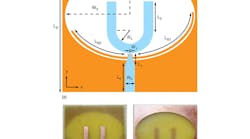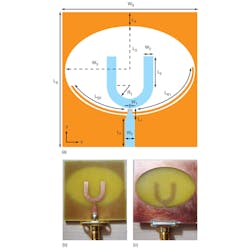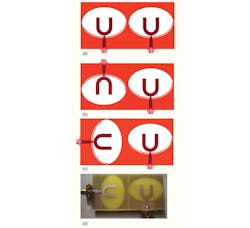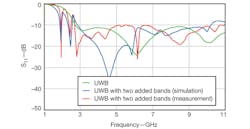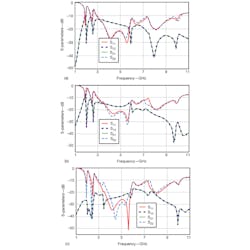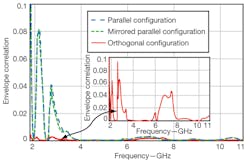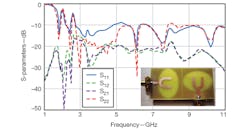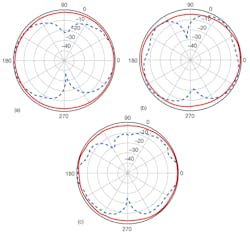MIMO/Diversity Antenna Serves Multiple Applications
This file type includes high resolution graphics and schematics.
Efficient communications design can take advantage of a single component for multiple uses, such as an antenna capable of operating across several different communications bands. Such an antenna is a triple-band printed slot design which can be used for multiple-input, multiple-output (MIMO) and diversity applications. The fork-shaped antenna operates within the ultrawideband (UWB) frequency range and uses two protruding stubs in the ground plane to add two more-narrow frequency bands below the UWB range.
The triple band antenna is suitable for UWB (3.1-to-10.6-GHz) frequencies as well as for 1.8-GHz GSM and 2.4-GHz Bluetooth systems. Different array designs of the antenna, including orthogonal and parallel configurations, have been studied and show good promise. The orthogonal array configuration of the proposed triple-band antenna was fabricated and provided low mutual coupling (better than -16 dB), low envelope correlation, and stable omnidirectional radiation patterns across all relevant bands.
Related Articles
• Conquer Testing Of IEEE 802.11ac MIMO
• Analyzer Checks MIMO To 26.5 GHz
• PXI Vector Analyzer Tackles MIMO
MIMO techniques have been used in wireless systems and have shown the capability to increase channel capacity and decrease fading effects.1 The antenna, of course, is an important component in these systems, and a MIMO antenna must have high isolation and radiation efficiency; stable radiation patterns; and low envelope correlation for array elements.2 Multiple-band antennas designed for MIMO applications are attractive for their efficiency, including an E-shaped triple-band design.1 and a quad-band (PIFA) antenna.2 MIMO antennas with generous gain and wide lobe patterns can improve the channel capacity of most systems.3
Some short-range, high-data-rate communications systems can benefit from multiple-band MIMO antennas, helping to increase the channel capacity of those systems.4 Some techniques have been reported to reduce the mutual coupling between the UWB MIMO/diversity antenna elements, such as the use of additional strips in the ground plane. Various approaches to improve performance include the use of tree-like structures,5 extending a narrow vertical strip in the antenna’s ground plane,6 and the use of a T-shaped ground plane.7 Unfortunately, these additional elements add size to the antenna and may detune it, due to the presence of metallic parts close to the antenna structure.2
A multiple-band antenna capable of covering UWB frequencies—as well as additional narrow bands—is useful for systems employing extensive frequency coverage or operating across multiple communications bands. Previous work has addressed adding Bluetooth coverage to an UWB antenna.8-10 In one instance, a narrow L-shaped strip was added to the corner of the base of an UWB printed antenna to add Bluetooth coverage.8 Bluetooth was also added to UWB antennas by attaching a quarter-wavelength strip to the high concentrated current area in the antenna’s ground plane.9 and by using a forked-shaped monopole antenna design.10 However, in all of these previous works, only one band was added to the existing UWB antenna coverage. The challenge is to add more than one band to an existing UWB antenna design, ideally with low mutual coupling between the antenna arrays.
To meet that challenge, a printed slot antenna was designed for use across the UWB frequency range, as well as in GSM and Bluetooth bands—an antenna suitable for MIMO/diversity applications. The antenna design was evaluated in different array configurations, using the commercial software package HFSS from Ansys for computer-aided-engineering (CAE) simulations. The measured results for the antenna agreed well with these simulations.
Figure 1(a) shows the geometry of the slot antenna. It was fabricated on low-cost FR-4 circuit substrate material using a substrate measuring 35 × 35 × 1.6 mm; the substrate material has a relative dielectric constant of 4.4 in the z-axis with loss tangent of 0.02. The antenna’s radiating patch is in the shape of a fork while the slot in the ground plane has an elliptical shape. Figures 1(b) and (c) show different views of the fabricated antenna, which covers the full UWB frequency range from 3.1 to 10.6 GHz with additional coverage of the GSM and Bluetooth bands.
1. The triple-band printed slot antenna is shown (a) in layout form and fabricated top (b) and bottom (c) views.
The base UWB printed slot antenna has parameters that include R1 = 3.5 mm, WS = 35 mm, WF = 2.5 mm, W1 = 0.3 mm, W2 = 2.5 mm, W3 = 16.7 mm, LF = 7 mm, LS = 35 mm, L1 = 3 mm, L2 = 7 mm, L3 = 10.6 mm, and L4 = 3.8 mm.By using an elliptic-shaped quarter-wavelength stub in the ground plane, additional frequency bands (such as Bluetooth and GSM) can also be covered. The total length of the elliptic-shaped stub can be obtained approximately from Eq. 1:
where εr, c, and f represent the relative dielectric constant of the substrate, the velocity of light in free space, and the center frequency of the added frequency band, respectively. By using two protruding stubs in the ground plane, two additional tunable bands are created below the UWB band. Through optimization, the dimensions of the stubs can be obtained as follows:
This file type includes high resolution graphics and schematics.
LS1 = 22 mm (the stub length related to the GSM band), and LS2 = 17 mm (the stub length related to the Bluetooth band). The width of the stubs and the spacing between each stub and the ground plane are chosen as 0.4 mm. Figures 1(a) and (c) show the configuration of two stubs.
2. The different versions of the triple-band antenna include (a) parallel configuration, (b) mirrored parallel configuration, (c) orthogonal configuration, and (d) the orthogonal array configuration that was fabricated.
With its high gain, wide impedance bandwidth, and omnidirectional radiation pattern, the printed slot antenna would appear to significantly increase the channel capacity for MIMO/diversity applications. But due to the surrounding ground structure in the printed antenna structure, the mutual coupling between the array elements in the diversity configuration is reduced significantly. Unlike the antennas presented in refs. 5-7, in which some elements were used to reduce mutual coupling between antenna elements, the proposed antenna design suffers minimal mutual coupling without any additional strips or stubs. Figure 2 shows different configurations of the antenna design, with the orthogonal array configuration fabricated and shown in Fig. 2(d).
3. These are the simulated and measured S-parameters of the proposed triple-band printed slot antenna, with simulated S-parameters forthe original printed single-band UWB slot antenna.
Figure 3 shows the simulated and measured reflection coefficients for the printed slot antenna. For comparison, the simulated reflection coefficients for the original UWB antenna, without added bands, is also shown. Figure 4 shows the current distributions for the antenna at 1.80, 2.45, and 8.00 GHz. For the frequencies related to the added bands (1.8 and 2.45 GHz), the current distribution is significantly high on the desired stubs. Figures 4(a) and (b) also show that the current distribution is at a maximum at one end of the stubs and at a minimum at the other, proving the stubs are quarter-wavelength and confirming the validity of Eq. 1. When one stub is activated the other is inactive, showing the independence of the added frequency bands from the basic UWB range.
4. These are simulated current distribution plots for the triple-band printed slot antenna at (a) 1.8 GHz, (b) 2.45 GHz, and (c) 8 GHz.
Figure 5 shows the simulated S-parameters for the different array configurations (depicted in Fig. 2). The reflection coefficient and mutual coupling for these designs can be determined by the values of S11, S22, S12, and S21, respectively. As Fig. 5 shows, good isolation is evident between the antenna ports in the different array configurations.
5. These plots show simulated S-parameters for the different array configurations:(a) parallel, (b) mirrored parallel, and (c) orthogonal.
The envelope correlation of the MIMO array structure, ρe, can be determined by the use of S-parameters1 in Eq. 2:
Figure 6 offers simulated envelope correlation of the different array structures of the proposed printed slot antenna. The envelope correlation of all array configurations is less than 0.25. The orthogonal array configuration has the best envelope correlation, at less than 0.004, which is much better than the generally accepted practical value of 0.3.1
6. These plots show thesimulated envelope correlation of the different array structures of the proposed printed slot antenna.
As shown in Figs. 5 and 6, all of the array configurations present high isolation between the antenna elements. However, the configuration in which the slot antenna elements have been placed orthogonal to each other, as shown in Figs. 2(c) and (d), has the best results in terms of low mutual coupling and envelope correlation; high radiation efficiency; and good radiation patterns. This is because the pattern and polarization of the orthogonal array antennas has a little effect on each other, resulting in less mutual coupling and envelope correlation. Because of the good results indicated by simulations of the orthogonal array configuration, that configuration was fabricated and then evaluated by means of measurements.
7. These plots show the measured S-parameters for the orthogonal array configuration.
Figure 7 offers the measured S-parameters for the orthogonal array structure. High isolation of better than -16 dB (better than -20 dB in most of the passbands) was achieved between the array ports. The reflection coefficient of the proposed array was also well below the -10 dB level across the passband frequencies. Figure 8 provides the measured radiation patterns for the proposed antenna array in both E- and H-planes at 2.45, 4.50, and 6.00 GHz. As can be seen, the antenna has a stable omnidirectional radiation pattern in its H-plane (x-y plane), making it quite suitable for MIMO/diversity applications. The simulated radiation efficiency of the proposed slot antenna is better than 88%. Its peak gain varies from 0.5 to 6 dBi. All of these results confirm that the antenna design is a good candidate for MIMO/diversity applications.
8.The plots are measured radiation patterns (in dB) for the proposed antenna design at (a) 2.45 GHz, (b) 4.5 GHz, and (c) 6 GHz. The solid line represents the H-plane (x-z plane)and the dashed line represents the E-plane (y-z plane).
In summary, this triple-band antenna operates in the UWB frequency range and at two narrowband frequency spans, making it suitable for a variety of applications. The antenna’s orthogonal array configuration provides stable omnidirectional radiation patterns, making the antenna a good fit for MIMO and diversity uses.
M.M. Samadi Taheri, Research Engineer
A.R. Mallahzadeh, Assistant Professor
S. Mohammad Ali Nezhad, Research Engineer
Electrical and Electronic Engineering Department, Shahed University, Tehran, Iran; e-mail: [email protected] (Samadi Taheri), [email protected] (A.R. Mallahzadeh), and [email protected] (Mohammad Ali Nezhad).
References
1. S. Mohammad Ali Nezhad and H. R.Hassani, “A novel triband E-shaped printed monopole Antenna for MIMO application,” IEEE Antennas and Wireless Propagation Letters, Vol. 9, 2010, pp. 576-579.
2. R.A. Bhatti, J.H. Choi, and S.O. Park, “Quad-band MIMO antenna array for portable wireless communications terminals,” IEEE Antennas and Wireless Propagation Letters, Vol.8, 2009, pp. 129-132.
3. R.G. Vaughan and J.B. Andersen, “Antenna diversity in mobile communications,” IEEE Transactions on Vehicular Technology, Vol. 36, 1987, pp. 149-172.
4. V. Tran and A. Sibille, “Spatial multiplexing in UWB MIMO communications,” Electronics Letters, Vol. 42, 2006, pp. 931-932.
5. S. Zhang, Z. Ying, J. Xiong, and S. He, “Ultrawideband MIMO/diversity antennas with a tree-like structure to enhance wide band isolation,” IEEE Antennas and Wireless Propagation Letters,Vol. 8, 2009, pp. 1279-1282.
6. T.S.P. Seeand Z.N. Chen, “An ultrawideband diversity antenna, IEEE Transactions on Antennas and Propagation, Vol. 57, 2009, pp. 1597-1605.
7. K.L. Wong, S.W. Su, and Y.L. Kuo, “A printed ultra-wideband diversity monopole antenna,” Microwave and Optical Technology Letters, Vol. 38, 2003, pp. 257-259.
8. B.S. Yildirim, B.A. Cetiner, G. Roqueta, and L. Jofre, “Integrated Bluetooth and UWB antenna,” IEEE Antennas and Wireless Propagation Letters, Vol. 8, 2009, pp. 149-152.
9. M.M.Samadi Taheri, H.R. Hassani, and S. Mohammad Ali Nezhad, “UWB printed slot antenna with Bluetooth and dual notch bands,” IEEE Antennas and Wireless Propagation Letters, Vol. 10, 2011, pp. 255-258.
10. S. Kumar Mishra, R. Kumar Gupta, A. Vaidya, and J. Mukherjee, “A compact dual-band fork-shaped monopole antenna for Bluetooth and UWB applications,” IEEE Antennas and Wireless Propagation Letters, Vol. 10, 2011, pp. 627-630.
This file type includes high resolution graphics and schematics.
